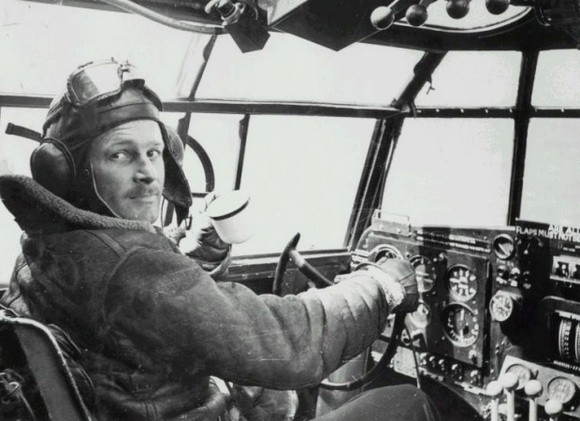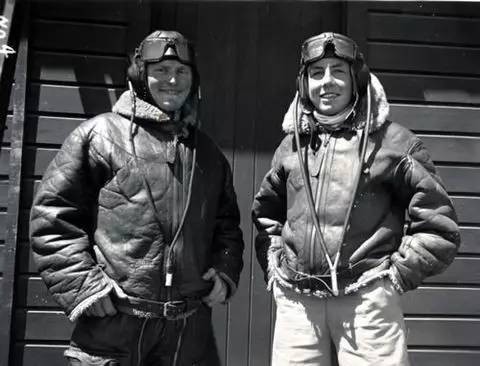
American aviator Leslie Irvin is predominantly known for designing the iconic RAF sheepskin flying jacket in the early 1930s, a jacket that would go on to later become synonymous with his name, however his this wasn't his first claim to fame, he was also the inventor of the parachute “rip-cord” system.
Irvin was born in Los Angeles in 1895. He became a stunt-man for the fledgling Californian film industry, for which he had to perform acrobatics on trapezes from balloons and then make descents using a parachute. Irvin made his first parachute jump when he was fourteen and jumped from an airplane for the first time in 1914, sailing 1,000 feet to the ground in a stunt for the movie Sky High. He later joined the Army Air Service's parachute research team at McCook Field near Dayton, Ohio. After World War 1, Major E. L. Hoffman of the Army Air Service led an effort to develop an improved parachute for exiting airplanes by bringing together the best elements of multiple parachute designs. Participants included Irvin and James Floyd Smith. The team eventually created the Airplane Parachute Type-A. In 1919, Irvin successfully tested the parachute by jumping from an airplane. The Type-A parachute was put into production and over time saved a number of lives. This was the first premeditated freefall parachute descent. With Smith flying the plane and Irvin making the jump, the new chute performed flawlessly, though Irvin broke his ankle on landing.
Less than two months later, The Irving Air Chute Company was formed in Buffalo, New York, the world’s first parachute designer and manufacturer, Legend has it that 'Irvin' was inadvertently changed to 'Irving' by a secretary who mistakenly tacked a 'g' on the end of the name. An early brochure of the Irving Air Chute Company credits William O'Connor 24 August 1920 at McCook Field as the first person to be saved by an Irving parachute. Two years later, Irvin's company instituted the Caterpillar Club awarding a gold pin to pilots who successfully bailed out of disabled aircraft using an Irving parachute. In 1926 he opened a factory in the UK, at Letchworth and by the end of the 1930s Irvin parachutes were in use worldwide.

As aviation advanced so did the altitudes to which pilots could fly. Suddenly aircrew were flying to thousands of feet where temperatures would easily be sub-zero, not a good thing when aircraft construction still provided basic, un-insulated cockpits. It was this situation that drove Irvin to create The Irvin Flying Jacket.
The design was approved by the Air Ministry in 1932, and although often referred to as the 'Irvin' its production was contracted out to many manufacturers in order to meet demand. Irvin’s jacket was made from heavyweight sheepskin, its thick natural wool provided incredible insulation. And, while the sheepskin was considered heavyweight the jacket itself was comparatively light and remarkably comfortable. Irvin insisted on the most supple sheepskin: in a cramped cockpit movement was already restricted and no pilot or crew would want to be constrained further still. The Irvin jacket was a masterpiece of design, maximum warmth and comfort combined with maximum mobility. The jackets had long sleeves zipped to enable gauntlets to be worn. The wide collar could be raised to provide excellent insulation around the neck and lower part of the head and face while a belt at the waist to ensure draughts couldn’t drop the pilot’s body temperature and reduce his level of alertness. The original jackets didn’t have pockets as these were not needed. The pre and early war jackets were manufactured with undivided one-piece body and sleeve panels. This produced a fantastic looking jacket, but proved to consume an extravagant amount of material. With the coming of war and the demand for greater quantities of jackets a more efficient use of the material was devised. The full piece panels were divided and subdivided into small pieces, resulting in a design made up of more seams.
In the Summer of 1940 the most famous air battle of the war took place over Southern England and the channel - The Battle of Britain. Although only just around the corner, the multi-panel jackets had not yet come into being, so the full-panel garments were all that were being worn during this time and hence are often referred to as the Battle of Britain pattern Irvin. After the war demand fell away and Irvin stopped producing jackets. Fans maintained a buoyant second-hand market, but eventually supplies dwindled away and the jackets became very hard to find.

Eastman offer three different models of this iconic flight jacket - the 1940, 1942 and 1944 patterns, each reproduction replicates the specific RAF jacket meticulously. One feature of some of the later war jackets was that they were produced from a breed of sheep (Devons) that had a unique curly character to the fleece. We are the only manufacturer to offer this model reproduction. The Devon breed is an extremely rare breed now, and accordingly the sheepskin industry yields very low quantities of skins that can be acquired. We offer this model whenever we can procure the skins, so it's only available for limited periods of time.
You can find these products in the Eastman British flight jacket section HERE
